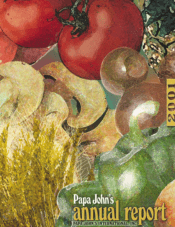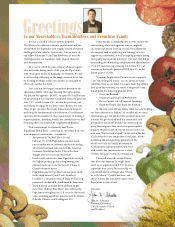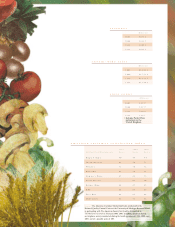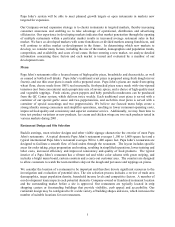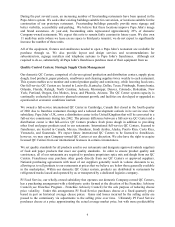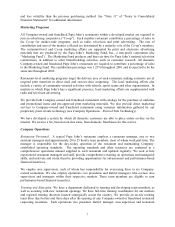Papa Johns 2001 Annual Report Download - page 9
Download and view the complete annual report
Please find page 9 of the 2001 Papa Johns annual report below. You can navigate through the pages in the report by either clicking on the pages listed below, or by using the keyword search tool below to find specific information within the annual report.5
Papa John’s system will be able to meet planned growth targets or open restaurants in markets now
targeted for expansion.
Our Company-owned expansion strategy is to cluster restaurants in targeted markets, thereby increasing
consumer awareness and enabling us to take advantage of operational, distribution and advertising
efficiencies. Our experience in developing markets indicates that market penetration through the opening
of multiple restaurants within a particular market results in increased average restaurant sales in that
market. We have co-developed markets with some franchisees or divided markets among franchisees, and
will continue to utilize market co-development in the future. In determining which new markets to
develop, we consider many factors, including the size of the market, demographics and population trends,
competition, and availability and costs of real estate. Before entering a new market, we analyze detailed
information concerning these factors and each market is toured and evaluated by a member of our
development team.
Menu
Papa John’s restaurants offer a focused menu of high-quality pizza, breadsticks and cheesesticks, as well
as canned or bottled soft drinks. Papa John’s traditional crust pizza is prepared using fresh dough (never
frozen), and our thin crust pizza is made with a prepared crust. Papa John’s pizzas are made from spring
wheat flour, cheese made from 100% real mozzarella, fresh-packed pizza sauce made with vine-ripened
tomatoes (not from concentrate) and a proprietary mix of savory spices, and a choice of high-quality meat
and vegetable toppings. Fresh onions, green peppers and baby portabella mushrooms can be purchased
from the QC Center system, which delivers twice weekly. Each traditional crust pizza is served with a
container of our special garlic sauce and two pepperoncinis, and each thin crust pizza is served with a
container of special seasonings and two pepperoncinis. We believe our focused menu helps create a
strong identity among consumers and simplifies operations, resulting in lower restaurant operating costs,
improved food quality and consistency and superior customer service. Additionally, we may from time to
time test product variations or new products. Ice cream and chicken wings are two such products tested in
various markets during 2001.
Restaurant Design and Site Selection
Backlit awnings, neon window designs and other visible signage characterize the exterior of most Papa
John’s restaurants. A typical domestic Papa John’s restaurant averages 1,100 to 1,600 square feet and a
typical international Papa John’s restaurant averages 900 to 1,400 square feet. Papa John’s restaurants are
designed to facilitate a smooth flow of food orders through the restaurant. The layout includes specific
areas for order taking, pizza preparation and routing, resulting in simplified operations, lower training and
labor costs, increased efficiency and improved consistency and quality of food products. The typical
interior of a Papa John’s restaurant has a vibrant red and white color scheme with green striping, and
includes a bright menu board, custom counters and a carry-out customer area. The counters are designed
to allow customers to watch the team members slap out the dough and put sauce and toppings on pizzas.
We consider the location of a restaurant to be important and therefore devote significant resources to the
investigation and evaluation of potential sites. The site selection process includes a review of trade area
demographics, target population density, household income levels and competitive factors. A member of
our development team inspects each potential domestic Company-owned or franchised restaurant location
and the surrounding market before a site is approved. Our restaurants are typically located in strip
shopping centers or freestanding buildings that provide visibility, curb appeal and accessibility. Our
restaurant design may be configured to fit a wide variety of building shapes and sizes, which increases the
number of suitable locations for our restaurants.

